Trigger Point Massage
A myofascial trigger point is a hypersensitive nodule found within a taut band of skeletal muscle or fascia. Other words, trigger points are knots that can be felt by touching. Palpation of these nodules reveals an area of harder than normal muscle consistency.
There are two basic classifications of trigger points: active and latent.
An Active trigger point causes pain at rest, and firm pressure applied over the point usually causes more pain. An Active Trigger Point is tender to palpation with a referred pain pattern that is similar to the patient’s pain complaint. The pain is often described as spreading or radiating. The place where you feel the pain is not necessarily the source or cause.
Here, the pain over the forehead and eye actually comes from a trigger point on the Sternocleidomastoid Muscle.
A Latent trigger point only exhibits pain when compressed, and it does not refer pain to other areas of the body.
Both active and latent trigger points are known to be a major cause of stiff joints and restricted range of motion.
The purpose of Neuromuscular Therapy (trigger point therapy) is to eliminate pain and to re-educate the muscles to perform pain-free habits.
After several treatments, the swelling, stiffness and pain are reduced, range of motion is increased, tension is relieved, and circulation, flexibility and coordination are improved.
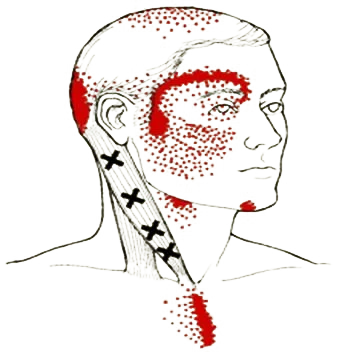
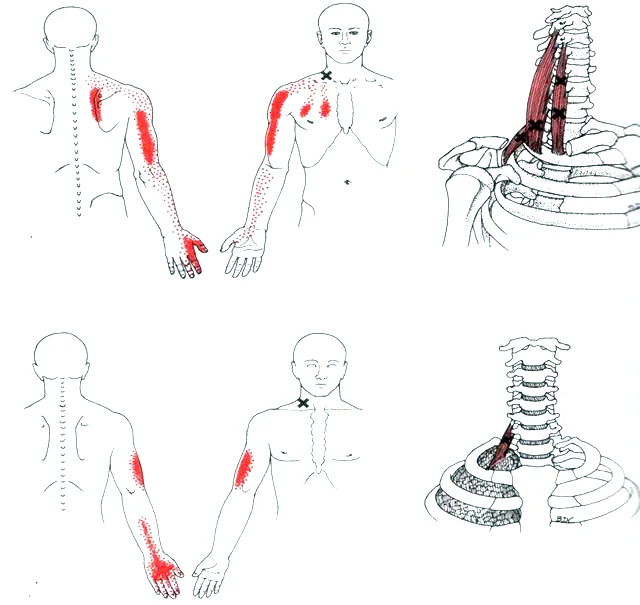
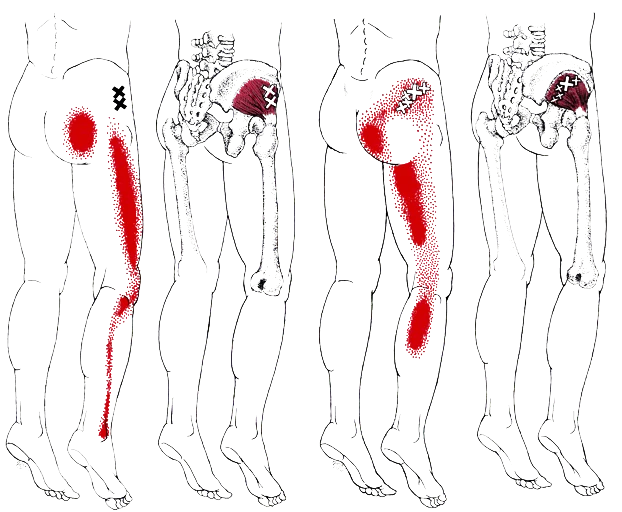
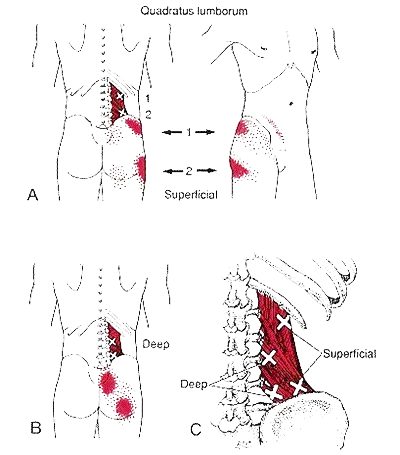
Deep Tissue Massage
Deep Tissue Massage is a form of bodywork that aims to relieve tension in the deeper layers of tissue in the body.
Deep Tissue Massage is a highly effective method for releasing chronic stress areas due to misalignment, repetitive motions, and past lingering injuries.
Due to the nature of the deep tissue work, open communication during the session is crucial to make sure you don’t get too uncomfortable.
Keep in mind that soreness is pretty common after the treatment, and that plenty of water should be ingested to aid with the flushing and removal of toxins that will have been released from the deep tissue during the session.
Proprioceptive Neuromuscular Facilitation
Proprioceptive Neuromuscular Facilitation is a technique used to increase range of motion, decrease sensitivity and increase strength and coordination.
One of PNF technique is HOLD- RELAX stretch.
The client is asked to contract the muscle group, while the therapist offer resistance.
The client holds the muscle in an isometric contraction in which no joint movement occurs and muscle length remains unchanged.
The client is than instructed to relax, and therapist passively stretch the muscle.
What is IASTM?
Instrument-Assisted Soft-Tissue Mobilization (IASTM) is an evidence-based manual therapy treatment using a stainless device to break down fascial scar tissues that surround muscle fibers and connective tissues of the body (Graston Technique, 2020). The concept of using metallic instruments for therapeutic purposes stemmed from ancient Greece and Rome when the “strigil” was used to scrape the skin clean in bathhouses, leading to the modern-day use of metallic instruments like Graston® tools in therapy settings (Kim, Sung, & Lee, 2017).
Additionally, IASTM also originated from a traditional Chinese manual therapy called “gua sha,” which means to scrape the skin using therapeutic instruments for a specific redness on the skin that increases blood and oxygen flow to the soft tissues to reduce sickness such as headaches and migraines (Kim, Sung & Lee, 2017). These two ideas of scraping the soft tissues with a metallic device lead to the modern-day IASTM therapy often known as the “Graston® technique” (Kim, Sung & Lee, 2017). The Graston technique was refined by David Graston in the late 1980s from the treatment idea by English orthopedist James Cyriax of crossing muscle fibers in massage therapy to alleviate muscle tension (Myofascial Correction, 2020). The IASTM instruments in therapy treatment are thought to benefit the client through deeper penetration, while also benefiting the clinician by reducing the demand and potential wear-and-tear on the hands. It is also believed to allow greater vibrations to be felt than through manual therapy which allows the clinician to detect any atypical areas that require greater focus (Cheatham, Lee, Cain, & Baker, 2016). The different tools and techniques in IASTM serve to provide patients with the best-individualized results, whether it is a large area on the back that requires tension relief due to lower back pain, or small areas on the palm of the hand from the stress of constant use of the thumb muscles (Lee, Lee, & Oh, 2016). The IASTM instruments should be applied parallel and perpendicular to the muscle fibers at a 45° angle for approximately 20-seconds or the amount of time necessary for the individualized treatment (Lee, Lee, & Oh, 2016). The selection of tools depends on the area on the body that is being worked on and the patient’s ability to receive IASTM treatment.
The main focus of IASTM is to return the individual to the client’s functional range of motion in their targeted muscle after the soft tissue is healed (Kim, Sung, & Lee, 2017). IASTM targets myofascial restrictions in the body, breaking up adhesions, and “[facilitating the] healing process through formation of new extracellular matrix proteins such as collagen” (Kim et al, 2017). “Fascia is an uninterrupted viscoelastic tissue which forms a functional 3-dimensional collagen matrix.” (Kumka & Bonar, 2012). Fascia binds and encloses bundles of muscle fibers. For example, the resulting inflammation following an injury and the creation of new cells can potentially result in fibrosis and formation of scar tissue in the injured soft tissue (Sato et al., 2003, as cited in Kim, et al. 2016). This can lead to adhesions and reduced elasticity, which may increase pain and decrease function (Huard et al., 2002; Melham et al., 1998, as cited in Kim et al., 2016). “Scar tissue limits perfusion to the injured soft tissue, restricting the supply of oxygen and nutrients, and interferes with collagen synthesis and regeneration of tissues” (Chen & Li, 2009; Gauglitz et al., 2011, as cited in Kim et al., 2016). Scar tissue is removed by IASTM and will facilitate “functional normalization around the soft tissue” (Black, 2010, as cited in Kim, et al. 2016). If done correctly with the appropriate pressure and shearing force of the instruments, IASTM can cause “microvascular and capillary hemorrhage, along with localized inflammation.” The “inflammation will remove the scar tissue and release adhesions, while also increasing blood and nutrient supply to the injured area and migration of fibroblasts” (Baker et al., 2013; Davidson et al., 1997; Gehlsen et al., 1999; Hammer, 2008, as cited in Kim, et al. 2016). As new collagen is produced and realigned, regeneration of the injured tissue can occur (Davies and Backopp, 2010; Gehlsen et al., 1999, as cited in Kim, et al. 2016).
Due to the effectiveness of IASTM in increasing blood flow and helping the muscles recover at a faster speed, IASTM has been implemented in various therapeutic settings for acute injuries such as sports accidents with athletes to a chronic diagnosis such as tendinopathy, that can cause injuries to the muscles (Kim, Sung & Lee, 2017; Lambert et al, 2017). Several educational institutions for physical therapy and chiropractic care in America have now organized IASTM training into their curriculum due to its various health benefits (Kim, Sung & Lee, 2017). The use of IASTM is now expanding into other rehabilitation settings such as physical therapy, sports therapy, occupational therapy, hand therapy, massage therapy, and so on. IASTM combined with other strengthening treatments has also been used for patients with musculoskeletal pathology to the upper extremities such as epicondylitis, carpal tunnel, and increasing shoulder range of motion (Cheatham, Lee, Cain, & Baker, 2016). IASTM can be used on patients of various diagnoses with specific contraindications and precautions to consider. IASTM courses and certifications are available for students working towards the following credentials: ATC, CHT, DC, DO, DOM, MD, MT, OT, OTA, PT, PTA (Hawk Grip, 2020).
Work / Stress Injury

- Headaches/ Migraines,
- TMJ Problems,
- Shoulder Pain,
- Neck Pain,
- Back Pain,
- Sciatica,
- Carpal Tunnel
Sport Injury
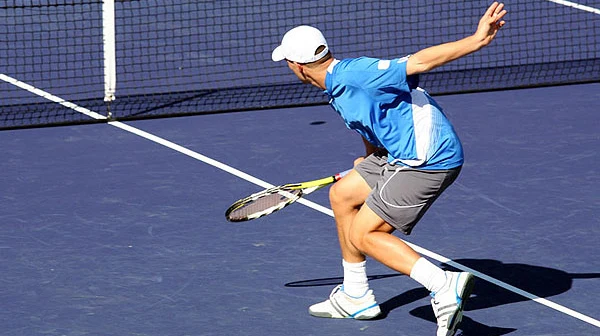
- Rotator Cuff Tendonitis
- Bicipital Tendonitis
- Frozen Shoulder
- Thoracic Outlet Syndrome
- Tennis Elbow
- Golfers Elbow
- Carpal Tunnel
- Piriformis Syndrome
- Shin Splint Syndrome
- Runners knee
- Jumpers knee